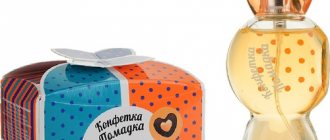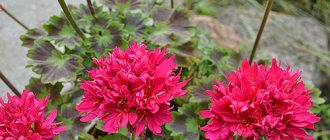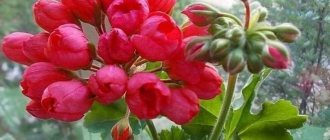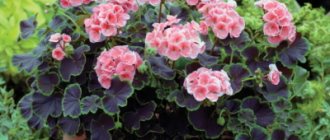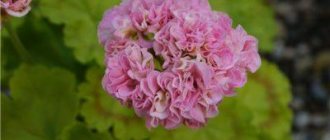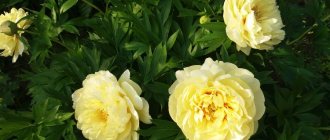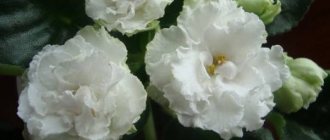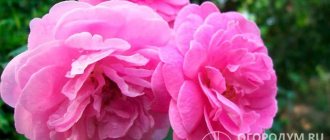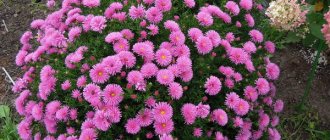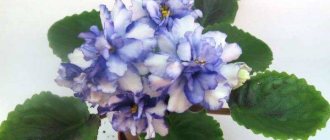Good luck in growing. Alena February 06, 2022, 21:48 // Guest book –
I want to say a big thank you to Alena for the wonderful children. All so beautiful, juicy and strong. Svetlana February 06, 2022, 12:32 // Guest book –
Of course you can, email the list. Alena July 26, 2022, 08:15 // Contacts – Flower Paradise
Thank you, Lyudmila! Good luck in growing. Alena July 26, 2022, 08:15 // Guest book –
Unfamiliar pelargonium: facts that will change your attitude towards “grandmother’s flower”
What do you know about pelargonium? Yes, yes, about that same pelargonium, which is often called geranium, or crane grass, or - even funnier - oak. About the one that from ancient times, decorating the windows of our grandmothers, grew in chipped bowls in the ground, similar to cement, and bloomed lushly and brightly.
What do you know about common pelargonium?
Do you know that pelargonium comes in white, pink and red? Just recently I thought exactly the same thing and firmly knew that there would never be pelargonium in my house. The bitter smell of its leaves seemed very tasteless to me.
Perhaps, to this day, I would not have changed my attitude towards them if I had not once happened to get into the garden of elderly Kaluga residents, fans of dahlias. They asked to take photographs for a local exhibition. Armed with a camera, I went to photograph the dahlias. They have a small plot, four hundred square meters of land. There is not a single bed - all dahlias, and on the high veranda in funny old saucepans, hanging down no less than one and a half meters, a solid wall of multi-colored ivy-leaved pelargoniums grew.
House of Kaluga flower growers, photo by the author
It took my breath away with delight; I had only seen such beauty in pictures in magazines. And it turned out that the foliage of this variety has no smell at all. It was then that the firm decision to never keep pelargonium in the house lost its firmness.
I was embarrassed to ask older flower growers for cuttings, and I understood that these plants are not for windows, they are for balconies and verandas, and I have neither one nor the other. Not yet knowing that this was possible, I began to look for something similar, but compact, so that I could keep it on the window in my apartment.
Pelargoniums conquer once and for all. You just need to get to know them better
Very soon I found a virtual club for pelargonium lovers on the Internet. This is a community of passionate people, fans of an amazing plant that has captured my heart once and for all. These people do a lot to popularize pelargoniums in Russia, they have created a catalog of species and varieties that are in private collections, are happy to share observations about all aspects of the life of pelargoniums, collect information about these plants bit by bit, and hold exhibitions.
It was there that I learned how diverse pelargoniums can be - from modest species forms to decorative luxurious bushes strewn with large inflorescences. It was there that I found the plant of my dreams. Now I have about 200 varieties and species of pelargonium in my collection, and the bitter smell of the foliage no longer seems unpleasant to me.
Pelargoniums on a walk, photo by the author
Would you like to know a little more about this amazing plant? Then let me bring to your attention a brief classification of pelargoniums that can be found in collections.
All about the dacha
Last year I became hooked on pelargonium. More and more new varieties were gradually added to my few wild bushes. Now there are about a hundred of them in my collection.
1.
The correct name for these flowers is “zonal pelargonium”. They are so called because of the darker or lighter zone on the leaves. In some varieties it is more pronounced, in some it is weaker, and in some it is practically absent. The shape of the zone can also be different - ring-shaped, from.
1. The most common type of zone in miniature pelargonium.
2. In this variety, the dark color zone extends from the center of the leaf; in bright light, the leaves become almost brown.
3. And this is a leaf with a “butterfly” zone, the variety is called Lorelye Butterfly.
4. A very peculiar coloring of the leaves - both a zone and a “butterfly”; because of such elegant leaves, the variety is called Peacock.
5. Not all pelargoniums have round leaves; there are these star-shaped varieties, which are called stellars.
6. And these are flowers, also non-standard.
7. Another stellar.
8. In tulip-shaped pelargoniums, the flowers retain their shape, remaining tulip buds.
9.
10. Do you think roses? Nothing of the kind, this is also pelargonium!
11. Royal pelargoniums are capricious ladies, many require a cool winter in order to bloom in the summer.
12. However, there are no complaints about this beauty - it started blooming in early April and hasn’t stopped))
14. Ivy-leaved pelargoniums require some experience in maintenance, especially in wintering - you probably can’t do without lighting.
15. The most beloved of the “plushs” is called Amethyst.
17. Many ivy-leaved plants have rosettes, this variety is called Ise Rose.
19. This variety is called Crocodile - I think everyone understands why))
20. And this is, perhaps, the most unusual of the ivy-leaved plants - a miniature bush, relative to the others, and quite round.
The variety of types and colors of pelargonium flowers is simply amazing! Simple and double, huge half-meter bushes and miniature bushes only 10 cm tall - there are many of them!
21. Many people really like these varieties - with huge dense caps of double flowers.
22. To be honest, I don’t really like double flowers, but I appreciate this variety for its neat bush and almost non-stop flowering.
23. Terry miniature snow white - Crown Princess Mary))
24. One of the most common series of varietal pelargoniums is PAC. Perhaps it is the most numerous and varied - both standards, and miniatures, and ivy, and royal ones...
Another very common, already slightly outdated series is Deacon. But some varieties are so beautiful that they are not removed from collections, remaining among the most beloved - such as this delicate Moonlight.
26. Peacoc, whose unusual leaves I showed at the beginning.
27. Another variety from this series is Bonanza.
A relatively new and very successful series of Higfield's, all varieties of which have low, strong bushes and large flower heads; they bloom almost non-stop, sometimes several heads at once!
28. This variety is called “Charisma”. Well, that is, that is, the name matches))
30. Tender “Serenade” from the Brookside series.
31. The Bold series represents mainly miniature pelargoniums - for example, Gold. Elf and Princess are simply beauties!
I'll show you a few more of my favorite varieties.
32. One of the most common and favorite among gardeners is the delicate beauty Lake.
33. Show Off - just lovely!
34. Cute flower with golden-green leaves and a cute name - Mimi))
35. This variety fully corresponds to its name - the inflorescence contains flowers of different shades of pink, as if it were indeed a bouquet!
36. Real orange!
37. I really love such simple and cute flowers!
38. A very common, old, but beloved variety by many.
39. Another popular variety is “Tamara”.
40. Honestly, I don’t know why the variety is called Autumn - it doesn’t remind me of autumn at all!
41. One of my favorites, name is Alice))
42. I really love varieties whose petals appear to be coated in color.
45. Quite a large plant with an unusual coloring of flowers, that’s what I’m holding on to))
46. So freckled...
47. A pair of pestles))
48.
49. Another delicate miniature, a very popular variety!
50 . And finally, here is such a bright flower with unusual leaves growing in almost a bunch on long petioles and incomparable flowers! Besides, almost my namesake...
Species pelargonium
Pelargoniums, which are found in nature in the wild. About 200 species of this plant are found in its habitats in southern Africa, in the Cape Province. First of all, they are interesting because without them not a single modern variety would exist. Some of the species of pelargonium can be grown quite easily in apartment conditions.
On the left is the species pelargonium p. fragrans, on the right is its hybrid - fragrant pelargonium 'Ardwick Cinnamon', with the smell of cinnamon. Photo by the author
Pelargoniums of this group amaze gardeners with an amazing variety of forms. They are so different that it is impossible to believe that they belong to the same genus. Among them you can find plants with caudex trunks, similar to bonsai; plants with leaves more like carrots; with flowers that look like exotic insects.
Fragrant pelargoniums
These are hybrids of pelargonium species. They are grown for their beautifully carved foliage and the pleasant aromas that the leaves emit. In the collections you can find scents with the scent of lemon and mint, rose and pineapple, with perfumery and confectionery scents, with the scent of cinnamon and apple, lilac and coconut, with resinous forest aromas.
Fragrant pelargonium with a sweet smell 'Fillicifolium'. Photo by Ekaterina Kotskaya
It is commonly believed that fragrant pelargoniums have simple and uninteresting flowers, but this is not so; there are many varieties of fragrant pelargoniums with large and beautiful flowers.
Graveolens Group
Varieties of aromatic pelargonium (P. graveolens).
- Camphor Rose is an upright growing plant, up to 45 cm tall, with deeply cut leaves with a strong aroma of camphor and mint. The flowers are purple-pink.
- Lady Plymouth is a very popular variety, 45-60 cm tall, thin white petaled leaves with a eucalyptus scent. Inflorescences of lavender-pink flowers appear in summer.
- Both's Snowflake is an upright grower, 30-60cm tall and wide, with deeply cut leaves sparkling with irregular creamy variegation, and scented with rose.
- Variegata - up to 60 cm, with pink flowers and variegated white-green leaves with the aroma of mint and rose.
Pelargonium Angels
Bush or ampelous plants with charming numerous small flowers, somewhat reminiscent of the flowers of royal pelargonium.
Inflorescence of pelargonium 'Eskay Verglo' from the Angels group. Photo by the author
The small flowers of plants of this group are two-colored. A spectacular combination of lilac, purple or pink with white gives the bush a particularly elegant look.
Numerous small two-color flowers are a distinctive feature of this group of pelargoniums. Photo by the author
Many varieties have fragrant leaves and bloom beautifully all summer.
Fragrans Group
Varieties of fragrant pelargonium (Pelargonium fragrans).
- Fragrans Variegatum is a subshrub up to 15 cm tall, often with reddish stems, leaves are velvety, three-lobed, blunt-toothed along the edge, light green, with a chartreuse-colored edge, with a spicy aroma. The flowers are white, collected in inflorescences of 4-8, the two upper petals with small red stripes.
- Lilian Pottinger - 25-30 cm tall and 12-16 cm wide, leaves are gray-green, irregularly three-lobed, serrated along the edges, with a complex aroma of camphor and pine. Produces masses of white flowers in summer with small red markings on the upper petals.
- Ardwick Cinnamon – has small, velvety, cinnamon-scented, dull green foliage and white flowers with crimson markings on the upper petals.
Zonal pelargoniums
The most famous group of pelargoniums with brightly colored flowers and rounded leaves with a clearly defined stripe - a zone. This group includes many different types, differing in growth form and flower color.
Miniature zonal pelargonium 'Cupid', the photo shows how small it is. Photo by the author
According to the growth form, standard, dwarf and miniature pelargoniums are distinguished. Based on the shape of the flowers , rosebud, tulip, carnation, cactus and star pelargoniums are distinguished.
Zonal pelargonium with cactus flowers 'Mrs. Salter Bevis', photo by the author Flowers of zonal pelargoniums have a variety of colors, they can be one-color or two-color; with a border along the edge or with contrasting spots on the petals (phlox), with a scattering of small colored splashes (speckled), with small contrasting spots and dots in the center of each petal (bird eggs). Inflorescence of zonal tulip-shaped pelargonium 'Emma fr. Bengtsbo'
The color of the leaves of zonal pelargoniums is also very interesting. They can be painted in two or three primary colors in various combinations of green, white, yellow, brown, red and even almost black.
You see how diverse they are - pelargoniums! Everyone can find a plant for themselves in this variety.
- Fans of exotic plants will definitely find it among the alien-like species.
- Adherents of aromatherapy will find their pelargonium among the fragrant ones.
- If you live in the country all summer, you simply need royal, ivy-leaved and standard zonal pelargoniums - they will decorate your garden.
- Do you spend the whole summer in the city? Your balcony and window sill can be decorated with ivy-leaved and zonal dwarf and miniature pelargoniums.
Pelargonium ivy 'Crock-O-Day' and 'Sandra Lorraine', photo by the author
Show Off
VKONTAKTE COMMUNITY
https://vk.com/fialki_sibir_ural| Flowers by train! |
Sending by train is possible to all cities if there is a direct connection from Tyumen to your city!
Year-round delivery of orders to the following cities:
Astrakhan, Baku, Vladivostok, Vladimir, Volgograd, Vyazma, Yekaterinburg, Irkutsk, Ishim, Kazan, Kamensk-Uralsky, Kemerovo, Kirov, Krasnoyarsk, Makhachkala, Megion, Miass, Minsk, Moscow, Nizhnevartovsk, Nizhny Novgorod, Novosibirsk, Omsk, Penza , Pervouralsk, Perm, Rostov, Samara, St. Petersburg, Saratov, Smolensk, Sochi, Surgut, Syzran, Tobolsk, Tomsk, Ulan-Ude, Ulyanovsk, Ufa, Khabarovsk, Chapaevsk, Chelyabinsk, Chita.
NEW Baby sets on sale:Violets – 10 children at a price of 1400 rubles. together with postage (without postage 1000 rub.).
Pelargoniums – 5 pieces 1000 rub. (without postage)
In the sets, children are selected at my discretion, different in color.
SPECIAL OFFERfrom 01/08/2018
Please keep track of the sale of children, starters, divisions, adult violet plants and pelargonium cuttings
| COMMUNICATION ON THE SITE |
Good luck in growing. Alena February 06, 2022, 21:48 // Guest book –
I want to say a big thank you to Alena for the wonderful children. All so beautiful, juicy and strong. Svetlana February 06, 2022, 12:32 // Guest book –
Of course you can, email the list. Alena July 26, 2022, 07:15 // Contacts – Flower Paradise
Thank you, Lyudmila! Good luck in growing. Alena July 26, 2022, 07:15 // Guest book –
How to grow pelargoniums
Another argument in favor of this culture is that almost all types of pelargoniums are easy to care for. They are quite undemanding when it comes to the composition of the soil mixture. The most common recipe for soil mixture for pelargoniums is this:
- 3 parts of purchased peat-based soil,
- 1 part coarse sand
- 1 part loamy garden soil.
Maintenance will not be difficult, the main thing is to remember and follow the rule: do not overfill! Pelargonium does not like excessive watering and stagnation of water in the pan. Watering should be regular but moderate.
Species pelargonium p. lanceolatum and variegated dwarf star pelargonium. Photo by Ekaterina Kotskaya
If I have convinced you, and you have already decided that in the spring you will get a rooted cutting of zonal pelargonium, then wait until it grows to 5-7 cm, transplant it into a pot 8-9 cm in diameter and pinch the crown. Dwarf and miniature varieties do not require careful shaping, as they themselves easily bush and form a dense crown. After some time, standard pelargonium will need to be transplanted again into a pot with a diameter of 11-12 cm.
You can choose pelargoniums for your home or garden in our catalog, where a wide range of products from large online stores of seeds and planting material is presented. Choose pelargoniums .
When the first buds begin to appear, you need to feed the plant with fertilizer with a high potassium content (any fertilizer for tomatoes or potassium nitrate will do), alternating it with a full complex one. By keeping pelargonium “in good shape” with fertilizing, you can achieve continuous flowering from spring to late autumn, and by providing illumination with fluorescent lamps, you will help it bloom even in winter.
Ivy-leaved pelargonium, photo by the author
Invite pelargonium into your home. When it’s damp autumn or cold winter outside, when you lack bright flowers, the smells of the garden, when you risk falling into autumn hibernation, a plant that is now fashionable, but so old and familiar to us from childhood, can help you out - pelargonium.
Characteristic
April Snow Pelargonium is a rosebud variety. This category of pelargoniums is capable of rapid growth while maintaining compactness.
It is impossible to convey the unusual colors of april snow pelargonium in a description; it definitely needs to be seen. Its color directly depends on the growing conditions, and all the splendor of its beauty is revealed under the influence of sunlight.
Pelargonium April snow
The same flower will grow completely different with limited access to light. Its petals will be deathly pale, thinned, with an aristocratic porcelain tint.
If you grow a flower under maximum lighting, the petals will acquire a delicate pink color, the edging of each will become bright red.
The core of each bud is painted in a dark green shade, surrounded by delicate, airy, corrugated petals, this combination is reminiscent of the first spring shoots that make their way through the April snow.
Characteristics and description:
- the inflorescences are dense and lush, consisting of many buds, up to 20 on one bush;
- color – variations of white, pink, light green;
- bush - low-growing and lush;
- petals – delicate, corrugated;
- tricolor buds, shaped like roses;
- the leaf is light emerald, large, smooth, with a characteristic brown stripe in the middle.
Pelargonium April Snov blooms all year round, it is not greedy for buds, it keeps the inflorescences on the stem for a long time, constantly releasing flower stalks on each branch.
Interesting! The bush is very compact, does not grow wide, and therefore does not require much space. A flower pot with pelargonium April Snov can easily fit on a narrow windowsill.
Features of cultivation
Pelargonium April snow belongs to the zonal type. If you do not pinch it, the stem of the plant will stretch upward; if formed correctly, it will turn into a lush “paradise” shrub.
The soil
Specialized flower shops sell soil for planting geraniums; it is better to purchase it there. On each bag of soil it is written what plants it is intended for.
You can buy universal soil, adding components that are better suited for April Snov pelargonium, or you can make soil yourself by mixing:
- garden soil - 3 parts;
- peat – 1 part;
- humus soil - 1 part;
- sand - 1 part.
Before planting, the soil is disinfected. There are several ways to do this:
- the prepared soil is poured into a metal container and fried in the oven or over a fire;
- frozen at low temperature;
- treated with fungicides;
- water with a weak solution of potassium permanganate.
The soil in the flower pot is changed every year.
Need to know! When soil is sterilized, not only harmful bacteria are killed, but also beneficial microflora, which enrich the soil with nutrients.
Watering
Important! Watering April Snow pelargonium requires the greatest attention; it must be constantly monitored. At different air temperatures, plants require different amounts of water.
Geraniums are often watered:
- in dry air and open windows;
- if it grows in a clay pot;
- during the flowering period;
- in bright light and high air temperatures.
Pelargonium needs less watering:
- when planting in a plastic pot;
- in a state of winter dormancy;
- a week after transplantation;
- at low air temperatures and in winter;
- with high humidity and lack of lighting;
- with poor ventilation of the room.
Water the bush at the root; to better moisten the soil, pour water into the pan.
An excess of moisture should not be allowed; soil moisture is checked at the edge of the pot at a depth of 1 cm; if it is dry, water it.
Important! It is better to take water for irrigation from a natural reservoir, melt or rain. Leave tap water for at least 24 hours before watering.
Fertilizer
All indoor plants have limitations in space, so the soil quickly becomes depleted and must be recharged frequently. After planting pelargonium, the soil is depleted after 2.5 months. You can notice that April Snow geranium needs feeding based on the following signs:
- the plant has become lethargic;
- the leaves have faded, drooped, and various spots appear on them;
- buds fall off, flowering has slowed down;
- the stem has lost its elasticity.
Important! Having noticed this condition in a flower, they feed the soil with a complex fertilizer suitable for this plant. Feed the flower once a month, diluting the concentrated preparation with settled water, as indicated in the instructions.
Fertilize the soil with folk remedies:
- egg shells - crushed, filled with water for 3 days and watered with this infusion on the ground;
- water in which the cereals were washed;
- water after washing fish;
- vegetable decoctions;
- tea and coffee infusions;
- yeast solution and onion peel tincture;
- a solution of ash and humus.
Traditional methods of fertilization fill the soil well with microelements and do not require any costs.
In order not to harm the plant when fertilizing with organic matter, first water the soil with plain water, then the effect of fertilizers will not be so aggressive.
During the “winter rest”, pelargonium does not need additional nutrition at all; it only makes the plants weakened.
Reference. After transplantation, the flower does not need fertilizer for 2 months, since during this time the soil still contains nutrients in the required quantities.
Temperature conditions, wintering
Almost all varieties of geranium prefer an air temperature of 20-25 degrees Celsius; April Snow pelargonium loves a cooler environment. It develops well and blooms at a temperature of about 17-18 degrees Celsius. In winter, it feels comfortable at 12-15 degrees Celsius, which is why this variety is successfully grown in the regions of Siberia.
When the plant goes into “winter sleep,” it can be placed on a windowsill that is located on the north side. If the windows are opened for ventilation, the geranium is removed from the windowsill so that the bush does not fall under a draft.
Reproduction
Important! It is better to purchase seeds and seedlings in a nursery or specialized stores, this will increase the likelihood of growing a real hybrid pelargonium April Snow, and not another variety.
Before planting, the seeds are rubbed a little between the palms and lightly squeezed, then soaked in a solution of manganese and a growth accelerator. The seeds are kept in each solution for 1 hour.
Seeds are sown in prepared soil to a depth of 0.3 mm at a distance of 5-6 cm from each other. Water the crops and cover them with film to create a warm microclimate. Open the film daily to ventilate the sprouts and moisten the soil. When 2-3 leaves hatch on the shoot, they are transplanted into a flower pot.
After planting, the young bush is cared for like an adult plant.
Propagation by cuttings is the most popular and trouble-free method.
A cutting 7-8 cm long is cut from a strong and healthy bush and rooted in this way:
- All leaves and growths on the cut shoot are torn off;
- lightly dry in the open air;
- placed in moist soil and left until rooting.
Interesting! Pelargonium April Snow is not rooted in water, like other varieties; the shoot will quickly rot in water. After 30 days, the cuttings will take root and can be transplanted to a permanent place of growth.
Show Off
| VKONTAKTE COMMUNITY |
| Flowers by train! |
Sending by train is possible to all cities if there is a direct connection from Tyumen to your city!
Year-round delivery of orders to the following cities:
Astrakhan, Baku, Vladivostok, Vladimir, Volgograd, Vyazma, Yekaterinburg, Irkutsk, Ishim, Kazan, Kamensk-Uralsky, Kemerovo, Kirov, Krasnoyarsk, Makhachkala, Megion, Miass, Minsk, Moscow, Nizhnevartovsk, Nizhny Novgorod, Novosibirsk, Omsk, Penza , Pervouralsk, Perm, Rostov, Samara, St. Petersburg, Saratov, Smolensk, Sochi, Surgut, Syzran, Tobolsk, Tomsk, Ulan-Ude, Ulyanovsk, Ufa, Khabarovsk, Chapaevsk, Chelyabinsk, Chita.
NEW Baby sets on sale:Violets – 10 children at a price of 1400 rubles. together with postage (without postage 1000 rub.).
Pelargoniums – 5 pieces 1000 rub. (without postage)
In the sets, children are selected at my discretion, different in color.
SPECIAL OFFERfrom 01/08/2018
Please keep track of the sale of children, starters, divisions, adult violet plants and pelargonium cuttings
| COMMUNICATION ON THE SITE |
Good luck in growing. Alena February 06, 2022, 21:48 // Guest book –
I want to say a big thank you to Alena for the wonderful children. All so beautiful, juicy and strong. Svetlana February 06, 2022, 12:32 // Guest book –
Of course you can, email the list. Alena July 26, 2022, 07:15 // Contacts – Flower Paradise
Thank you, Lyudmila! Good luck in growing. Alena July 26, 2022, 07:15 // Guest book –
Diseases
April Snow pelargonium does not tolerate high humidity - fungal diseases develop from dampness. The fungus appears as a gray coating on the stems and petioles, spots on the leaves, and the ground near the trunk becomes covered with mold.
If a fungus appears, remove all affected leaves and treat the bush
antifungal agent for indoor flowers "Fluconozol".
If the plant is severely affected by the disease, you need to take healthy shoots from it, soak them in an antifungal drug and grow a new bush.
On a note! When infected with a virus, the plant weakens and the leaf core turns yellow. Such a flower cannot be propagated, because the virus cells infect all parts of the bush.
